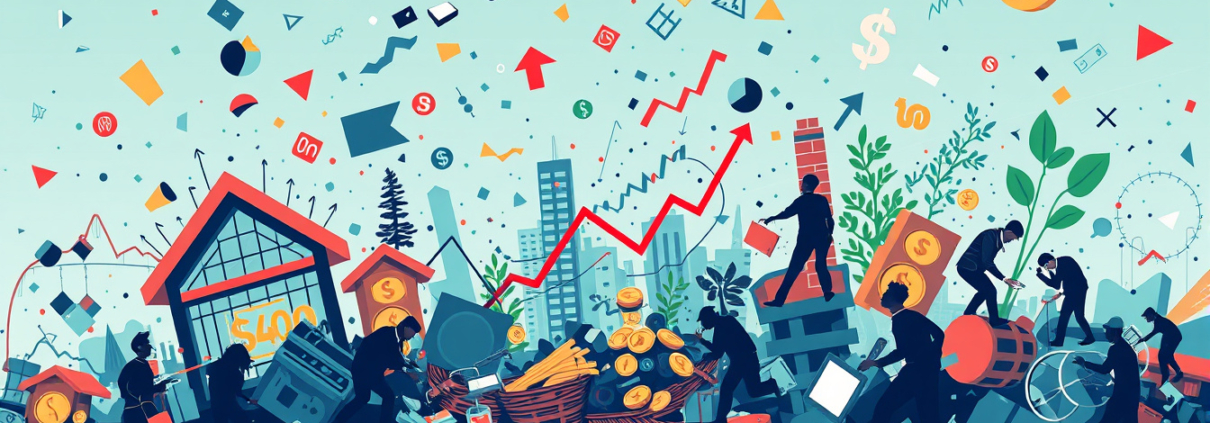Unpacking the Economic Chaos: Whatโs Causing Financial Distress Across All Sectors? ๐ธ๐ฅ
Today’s economic landscape shows many signs of money troubles. Every sector feels the stress. What fuels such chaos? A talk about America’s money state shows many causes. They arise from government rules, breaks in supply, and changing ideas of wealth and class.
The Backbone: Individual Responsibility and Wealth Building
America’s capitalistic system still gives a way for people to make money. The speaker puts it like this:
โThe little man has a better chance… it’s all about taking responsibility and making decisions.โ
We build wealth with a simple rule โ assets minus liabilities. A millionaire is someone whose net worth goes past $1 million. This idea differs from common talk, which often mixes up income with wealth.
One large study of more than 10,000 North American millionaires found:
- 89% did not become millionaires through inheritance.
- 79% received zero inheritance.
- Small inheritances (like $5,000) rarely push someone over the line.
- Big inheritances usually come only after a person has built wealth.
This shows one key takeaway: self-made wealth thrives in America even if the road is hard.
The Shifting Middle Class and Inflation
The idea of being middle class has changed since 1960:
- Then: A 1,100 sq. ft. brick home and 1.2 cars.
- Now: A 2,800 sq. ft. two-story home and about 2.3 cars.
These changes have bred a group some call โthe richest poorโ โ people who own more but still feel financial pressure.
Most of today’s inflation links to rules made during and after the COVID-19 crisis:
- Huge amounts of money were printed without much care.
- Some rules ended up paying people to stay at home.
- Factories and supply chains stopped during the crisis, which cut supply while demand did not drop evenly.
- Extended government cash support left many unwilling to work again.
These events caused a strong mix of supply and demand troubles. Prices rose in almost every group except oil. This money storm compares to an earthquake in the sea that later sends harming waves on the land โ the pandemic shook the world economy, and the effects came later.
The Consequences of Labor Shortages and Government Interventions
Service jobs have suffered the most, especially for those with low income. Two problems hit them:
- Shutdowns during the crisis.
- Ongoing government aid without work rules.
These points have led to a shortage of workers in restaurants and hotels, where many jobs remain unfilled.
This state is not just bad; it will not last. When rules try to help too much, they might:
- Make people less eager to work.
- Create a need for help.
- Slow down the recovery of the economy.
The fix means a return to the old style of capitalism โ one where effort pays off and aid goes only to those who really need it.
Practical Wisdom and Wealth Strategies Amid Chaos
In a time when money matters are tough, fear can make people choose fast but risky plans. Data and experience support a slower, steadier way:
- Put money into mutual funds with a long record.
- Buy property using cash when you can.
- Follow clear, small steps:
- Pay off debt.
- Save an emergency fund.
- Save at least 15% of your income for retirement.
Using this way, a family that earns $60,000 a year and saves 15% from age 30 to 65 might grow a nest egg of $5 to $10 million. This shows that becoming a millionaire can come from constant and careful work.
Summary: Root Causes of Financial Distress
- Shutdowns and breaks in supply caused by the crisis.
- Rules that lower the drive to work.
- Too much money printing that makes prices rise.
- Shortage of workers in key service jobs.
- Changing ideas about middle-class life.
- Rising fear that leads to unsafe money moves.
Fixing these issues needs rules that work in real life, giving power back to working people, and keeping sound money habits.
FAQs
Q1: What caused the recent rise in prices across many sectors?
A1: The fast rise in prices came mostly from supply breaks during the crisis, too much money printing, and fewer people working because of rules that paid them to stay home.
Q2: Are most American millionaires self-made, or did they inherit wealth?
A2: Around 89% of millionaires in North America made their own wealth without relying on large inheritances.
Q3: What steady steps can people take to build wealth during tough times?
A3: The best plan is to invest slowly in proven mutual funds, buy property with cash when possible, pay off debts, keep an emergency fund, and save about 15% of your income for retirement by taking simple, deliberate steps.








